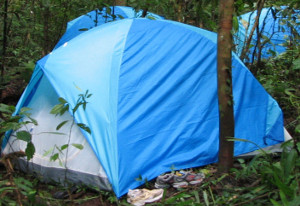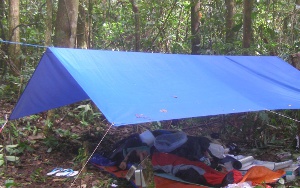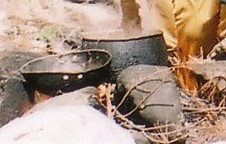
|
SOP (standard operating procedure)
Darkness falls quickly in a tropical rainforest and you want to make full use of the daylight. In most circumstances, setting up the tent is a priority over most other activities such as going for a bath at the river or preparing dinner. Avoid going far from the campsite at night. The trail may not be obvious in the dark and to avoid encountering wild animals. As a general recommendation, the following are the activities to be performed upon reaching the campsite in terms of priority,
- If socks and boots are wet, remove them. This is to reduce the chance of getting fungal infection.
- If you have dried food for rehydrating or pasta, soak them in water. Rehydration takes time.
- Setup tent. You would not want to be caught in the rain before your tent is setup.
- Gather campfire materials. This may require venturing further from the campsite. Better to gather them before dark.
- Collect water if campsite is not beside water source. Try to stay at the campsite when darkness falls. This is to avoid getting lost or encounter with wild animals in the dark.
- Bath. It is not recommended to enter the river at night.
- Cook dinner. Easier to cook when there is daylight but otherwise, it is just a minor inconvenience.
- Change to clean sleep wear. Good to have dinner in clean clothes.
- Have dinner and wash the kitchenware.
- Rest for the night.
Buddy system
For safety, always inform your buddy or someone if you are going out of the main campsite area such as to the designated latrine or to the river. Where possible, go in pairs.
Condensation
Tropical rainforest is known for its high humidity and water will condense on any gears that are left exposed outside overnight. This includes your clothes that are being hung out for drying or boots. Keep them under your tent vestibule or wrap in a groundsheet before you retire for the night. An exception is T-shirts which you have washed and is dripping wet. While they will still be damp from the condensation, they are better than dripping wet. The damp T-shirt maybe hung on the backpack to dry while trekking.
When setting up the tent, make sure the tent flysheet is not touching the inner tent wall. Otherwise, condensed water will seep into the tent inner wall and making the tent interior wet.
Good Tent Practice
Always zip up the mosquito net immediately after entering or exiting the tent. You do not want insects or mosquitoes to be trapped inside when you sleep.
It is a good practice to leave your dirty gears, shoes and even backpacks outside the tent. This is to keep the tent interior clean for the night.
Avoid eating inside the tent unless it is raining. There is usually no need to risk dropping food crumbs (which will quickly turn moldy) in the tent when the air is fresher outside.
Sanitation, See Hygiene and Sanitation
Cleaning and Washing of kitchenware, See Hygiene and Sanitation


